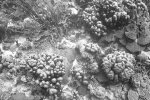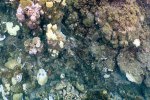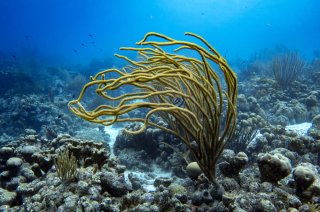
Longread
Can the tide be turned for coral reefs in the Caribbean Netherlands?
The coral reefs in the Caribbean are not doing well. In a period of 50 years, over 50 percent of the coral has perished. The causes of this are diverse and require a regional and global approach. However, a recent expedition by Wageningen Marine Research (WMR) has shown that local measures can also contribute to the resilience of the coral. ‘Tackling pollution in certain “hotspots” can already make a difference', says coral researcher Erik Meesters.
The Dutch Caribbean island of Bonaire is surrounded by coral reefs. On its western side, where the sea is calm and the shore is a haven for tourists, Erik Meesters, researcher at Wageningen University & Research (WUR), has had clear insights into the condition of the coral reef for years. However, the researcher of tropical marine ecology wanted to map out the coral on the other side of the island, too. ‘Here, the wind blows freely and the water is turbulent. The presence of large fields of floating seaweed makes this a dangerous spot for boats, as the weeds can clog up the engine’, he explains.
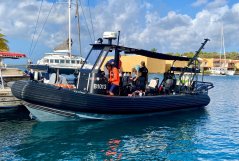
In the spring of 2024, with a suitable boat and calm weather conditions, he was finally able to sail out to the eastern side of Bonaire. Nevertheless, it was still a tense voyage, Meester says: ‘My colleague Thomas Kemenes van Uden and I quickly lowered a special camera, snapped pictures of the coral every other second, pulled it back up and rapidly moved to the next spot’, Meesters says. ‘All the while, the boat was roughly buffeted by the waves and water washed over us constantly.’ Four days later, Meesters had photos of 118 locations on the windward side of the 50-kilometre island. ‘The coral on this side turned out to be a lot healthier, with more vibrant colours and greater diversity than on the side we visit more often.’ Still, the difference between the east and west of Bonaire is not necessarily a cause for hope.
Coral reefs in jeopardy due to diseases and climate change
All over the world, coral reefs are under serious pressure. For their energy, the slowly growing polyps depend on algae residing in the tissue of the corals. Without these algae, the corals don’t last long. Other single-cell algae can overgrow the coral or occupy open spaces on the seafloor, preventing corals from growing here. A combination of stress factors has, in the past fifty years, led to a decrease in coral of over 50 percent. Meesters: ‘I have witnessed this deterioration in the Caribbean for years.’ The researcher has been performing fieldwork on Bonaire and the other Caribbean islands of the Kingdom of the Netherlands since 1987. The dataset with photos he has been maintaining features no less than 50 years’ worth of photos of the coral reefs of Curacao and Bonaire. ‘A unique dataset, and the oldest out there.’
Corals are susceptible to pollution. They have adapted to low-nutrient environments, lots of light and few temperature fluctuations
The new measurements made on the harsh eastern side of Bonaire confirm a number of the universal causes of coral deterioration. First, sea urchins were struck by disease. These sea urchins grazed in spots that didn’t have coral, keeping them clear of algae. Now that these animals are gone, a layer of algae covers the seafloor. On top of this, Meesters has observed the spread of a new coral disease, which was likely introduced through the ballast water of ships. ‘These types of diseases often first appear near ports, after which they spread to the entire shore of the island.’
Coral cover 1974 and 2023. Coral cover remained relatively constant in the past 15 years. The most significant deterioration took place between 1974 and 2010. Since 2010, coral cover has fluctuated between 20 and 25%. However, the composition of the coral population has changed to more opportunistic species that can appear and disappear more quickly, making the population more vulnerable and liable to disappear from one year to the other.
The third stress factor is coral bleaching. This is an especially likely scenario when water temperatures rise to or above 29 degrees. Since the nineties, this has happened with increasing regularity, causing the disappearance of the algae. ‘What you see is a white expanse underwater, like a ski slope.’ Due to climate change, water temperatures rise to these values more often and, moreover, these heat waves persist for longer. This prevents the coral from recovering. After a few weeks without algae, the coral dies.
No sewers, but cesspits
Meesters recognises universal factors on either side of Bonaire. The difference between east and west does have a different explanation, however, and this is due to population pressure. In 2010, Bonaire became a so-called special Dutch municipality. This resulted in the influx of immigrants, leading to a population increase from 12 to 24 thousand. ‘Everyone lives at the lower western side of the island, sheltered against the sea winds from the east. The problem is that few houses are connected to the sewer system. Most waste ends up in cesspits, and enters the sea through the soil. Overflowing cesspits are even emptied into the sea and heavy rains likewise cause much of this pollution to end up in the water. This all happens at the lower west side where everyone lives. The population growth did not improve matters.’
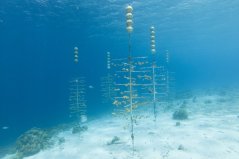
Corals are susceptible to pollution. They have adapted to low-nutrient environments, lots of light and few temperature fluctuations. As such, the combination of the abovementioned stress factors is a staggering blow to the coral’s chances of survival. Much of the coral has been weakened by disease while receiving extra nutrients from the land, sometimes boosted by rainfall. On top of this, the coral suffers from long periods of high temperatures, Meesters summarises. ‘These days, the coral has no time to recuperate before the next blow. The reef is losing its resilience.’
Consequences for fish and humans
The result of this is that the biodiversity in the Caribbean coral reefs is decreasing ever further. Meesters: ‘A variety of fish and other animals use the coral reef for shelter and to hunt and scavenge for food. Their habitat is decreasing. On top of this, the deterioration of the coral also poses risks to the human population. Corals build imposing structures that protect the coast. If those structures disappear, the waves have no obstruction, especially in areas home to lots of people. Already, some houses are flooded every two years. This is only going to get worse.’
Because we perform far more measurements than before, we can point out pollution hotspots
The coral reef on the western side of Bonaire won’t disappear altogether, Meesters expects. Several types of coral can still thrive even in current circumstances. These types of coral are now being cultivated successfully to restore coral reefs. The first cultivated corals are already growing on the reefs off Bonaire. ‘These are bold attempts, but I still worry’, Meesters laments. ‘Coral restoration alone is not enough if the surroundings don’t change. Nature will recuperate, as long as we improve its circumstances. Too little is being done in this regard.”
Pollution hotspots are the key to recovery
Meesters advocates for tackling the causes of coral deterioration – and presents his photos as evidence. ‘This means curbing global warming at an international level and highlighting the effect of local pollution. The differences between the east and west side of the island clearly show that local causes are in play, too. Because we perform far more measurements on the west side of the island than before, we can even point out pollution hotspots. That’s where the measures will be most effective.’ He is in contact with both local and Dutch government about the results and hopes they will take measures, like connecting more houses to the sewer system. ‘This would have a significant positive effect on coral health. It would be great if we could start seeing the first signs of recovery in coming years.’
These days, the coral has no time to recuperate before the next blow. The reef is losing its resilience
Back in the Netherlands, Gulsah Droguer and Owen Clements, Meesters’ colleagues, are preparing the next expedition. This one will take them to the island of Saba, where they will collect footage of the coral reefs using four submarine drones. They are testing the devices in a diving tower in Den Helder, hoping that they will stay operational for longer than before. ‘The equipment we use for our research deteriorates quickly due to the salt water. This is a persistent challenge.’ This doesn’t stop Meesters from the tireless pursuit of researching coral reefs and pointing out the causes of coral deterioration. ‘I will keep driving home the message that local causes like pollution need to be tackled. Where there’s a will, there’s a way.’
